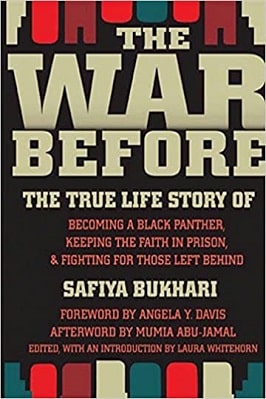
| Book Title | The War Before |
| Book Author | Safiya Bukhari |
| Total Pages | 311 |
| Book Views | |
| Language | English |
| Book Download | PDF Direct Download Link |
| Get Hardcover | Click for Hard Similar Copy from Amazon |
The War Before – The True Life Story of Becoming a Black Panther, Keeping the Faith in Prison, and Fighting for Those Left Behind by Safiya Bukhari, Laura Whitehorn, Mumia Abu-Jamal, Angela Y. Davis
Book introduction
, the iconic image of the 1960s is not a picture of hippies with daisy-wreathed hair dancing in the rain during the days of peace, love, and music at Woodstock.
It is a photograph splashed across the front pages of Chicago newspapers in December 1969. Four grinning Chicago police officers, all of them white, carry a trophy: the bullet-ridden body of a young Black man.
THE WAR BEFORE – THE TRUE-LIFE STORY OF BECOMING A BLACK PANTHER, KEEPING THE FAITH IN PRISON, AND FIGHTING FOR THOSE LEFT BEHIND
Fred Hampton, leader of the Illinois chapter of the Black Panther Party, was twenty-one years old when the cops murdered him. Other photos show his body lying face down on the floor of the apartment where he and fellow Panther member Mark Clark had been shot to death in their sleep. Still, another depicts Fred’s blood-soaked mattress.
At first, the photos appeared accompanied by accounts from Illinois State Attorney Edward Hanrahan saying that the police had been defending themselves from bullets fired by Panthers within the apartment. But it quickly emerged that this “shoot- out” had been something quite different.
As the Panthers and their lawyers unveiled physical evidence showing that all but one of the more than ninety shots had come from the police, it became clear that this had been a deliberate policy assassination, targeting the powerful Black Panther Party leader.
This was, in fact, a premeditated act of war conducted by police-assisted, we were later to learn, by the FBI. Other images of Fred Hampton and the Black Panther Party describe another side of that war-and help explain why the Panthers, and Fred in particular, were targeted.
These photos, taken at rallies, marches, community-organizing projects and meetings, are flooded with a riot of emotions: anger, joy, humour, and most profoundly, the tremendous creative energy unleashed by a struggle for liberation. The Panthers sparked that energy. Their programs and their organizing led Black people around the country to take control of their communities.
In those programs, many of the people in these communities saw themselves-not as white institutions or politicians—as the source of change, achieved by working collectively. Another emotion visible in those images—and palpable to anyone who attended a Panther rally in a park or church or on a street corner at that time—was hope.
In the context of a struggle for justice and freedom, hope was such a powerful emotion that the FBI and police found it necessary to use the tools of warfare to obliterate it. When we learned that night that Fred had been killed, those of us in a collective of Weatherman (soon to become the Weather Underground Organization) felt fury and grief, but not surprise. We had been prepared for this.
My own preparation had been short and dramatic. It had only been fourteen months since, one hot August afternoon in 1968, I had been sitting at my desk in Hyde Park, Chicago.
I was then a disaffected, twenty-three-year-old graduate student preparing for PhD exams in English literature. In my second-floor apartment, I looked up from Mil- ton’s Paradise Lost to gaze out the open window onto a quiet street scene: a sidewalk, some trees, a fire hydrant, and a young Black man walking down the block. Suddenly a police car pulled up.
Two officers jumped out and grabbed the man, throwing him up against a building, frisking him, and demanding that he tell them who he was and what he was doing on that street. Impulsively, I ran outside, where I tried to convince the cops to let him go. They threatened to arrest me as well.
The young man struggled a little, then was arrested- not for anything he did, but for answering police questions too slowly. He was later released with a warning. I did not go back to my desk that day.
I did not return to my studies at all. That past April, a few months before I’d moved to the city, the mayor of Chicago had called to the West Side, not just the police but also the National Guard.
They were given orders to “shoot to kill” anyone caught destroying property in the out- burst of grief and rage following the murder of Martin Luther King Jr. After years of standing up to the fire hoses, bullwhips, and billy clubs of southern police forces during the civil rights movement, Black people now watched their northern communities turn into occupied territories.
Instead of accepting and meeting Black people’s demands for equal rights, the government had responded by initiating a domestic war in the streets of our country.
The domestic war was easier to comprehend in the context of international events. I had already developed a vague sense of this context from teach-ins and rallies during those years when protests against the threat of nuclear war expanded into something broader and more radical.
In stuffy, darkened high school and college classrooms, I had watched grainy newsreel films and documentaries showing how the US government habitually intervened both clandestinely and openly in suppressing democracies around the world. The United States was not only waging a war against the people of Vietnam. The government had also been complicit in the overthrow of the democratically elected
To read more about the The War Before book Click the download button below to get it for free
Report broken link
Support this Website
Click here to join our Telegram group for new Books